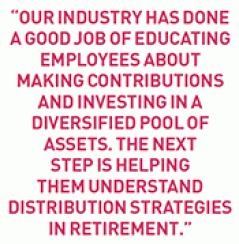To view a PDF of the report, click here.
Retirement security is a top-of-mind concern for participants in defined contribution (DC) plans as well as for older retirees. However, millennials (Gen Y), Gen Xers, and baby boomers (both working and retired) have differing financial priorities, and sponsors of 401(k) and other DC plans should consider a variety of strategies to engage their participants. Today, one size definitely does not fit all.
Both DC plan participants and retirees are engaged audiences, according to Kristen Colvin, Director, Investment Solutions Group, MFS Investment Management.
“There is an opportunity for sponsors to connect with them — not just for investment products, but to address the other financial pressures and concerns, such as student debt, mortgage debt, and health care expenses,” she says. “Don’t just focus on how you communicate. The messages you send should be very different based on age and the issues facing each cohort.”
MFS recently conducted a global survey on retirement income involving both DC plan participants and retirees. “One of the most important findings was that the different generational cohorts think about retirement very differently,” says Colvin. “Plan sponsors can take these differences into account when communicating with and educating their participants in order to increase the effectiveness of the message.”
For example, reducing debt is typically the top financial priority for millennials. For older generations, debt management is a much lower priority. The survey also found that many retirees are staying in a former employer’s plan as a primary source of income.
Many Gen Y participants, prone to loss aversion, are skeptical about investing in the equity markets. “Our surveys have shown there is often a disconnect between reality and perceptions, particularly when it comes to risk,” says Ravi Venkataraman, Senior Managing Director, Investment Solutions Group, MFS. “Those misperceptions can influence participants’ choices and should be considered in the plan’s investment menu design.”
On the positive side, Gen Y and Gen X participants are saving at a higher rate than older participants, according to a recent “Boomer Report” from the Insured Retirement Institute (IRI). “Our research shows that 64 percent of Gen Xers, and 68 percent of millennials, are contributing to defined contribution plans,” says Cathy Weatherford, IRI’s President and CEO. “However, relatively few in either generation have tried to calculate how much they should be saving, or consulted a financial professional.”

“Our industry has done a good job of educating employees about making contributions and investing in a diversified pool of assets. The next step is helping them understand distribution strategies in retirement,” she adds.
Sponsors should also reinforce the investing basics, such as compounding interest, diversification, and sequencing risk. “One of the best ways to help participants is to communicate in simple and straightforward language,” says Venkataraman. “For instance, you could quantify the impact of different financial decisions using actual dollar amounts, rather than percentages.”
Millennials’ DC plan choices
Gen Y participants may be doing better at allocating assets than older plan participants, according to Andrew Arnott, President and CEO, John Hancock Investments. About 59 percent of 401(k) plan participants under age 30 in the John Hancock Retirement Plan Services database were within the recommended equity exposure range for their age group, compared with 27 percent of those 40 to 49 and 19 percent of those 60 and above.
Sponsors should also take the preferences of millennials into account when designing plans, particularly the target date fund (TDF) offerings. “Many younger participants have indicated high interest in having an environmental, social, and governance [ESG] option available in their plans,” says Arnott. “They want to feel that their contributions are making an impact on issues that reflect their personal values. They also want to extend their personal brands into the investment field. We will see more TDF strategies designed to provide exposure to ESG factors, as we are just at the beginning of that trend.”
Considering TDF designs
When plan sponsors consider TDF options, the best solution may not be a product with a one-size-fits-all glide path that determines the asset allocation mix for all participants based on the number of years to the target date.
“Instead, it’s important for sponsors to consider different glide paths, based on their participant demographics,” says Arnott. “In addition, multiple product constructs — including fully passive, fully active, and combined strategies — allow a fiduciary to find a solution that best complements its specific plan.”
In terms of plan design, Arnott says more sponsors are considering TDF options beyond the proprietary products of the recordkeeper. “From a fiduciary perspective, a TDF solution using multiple managers has the potential to offer benefits beyond those available through a single-manager fund,” he says. “Because no asset manager can be equally good at everything, engaging specialists in each asset class has the potential to improve performance.”
Arnott adds that cost is always an issue for plan sponsors, particularly when comparing pure passive and pure active products; the expenses are known, but the performance is uncertain. “During the most recent period, passive index funds have generally outperformed actively managed funds,” he says. “However, that could change going forward, given the financial and geopolitical challenges facing the world today.”
Many plan sponsors are using consultants and other financial professionals to help them make well-informed decisions in that regard, he adds.
Retirement income options
While maintaining appropriate equity allocations is important for all plan participants, baby boomers in their pre-retirement years are more concerned about income than growth, compared with Gen Yers and Gen Xers. “Traditionally, the most conservative fund in the TDF has been the landing pad for folks close to retirement,” Arnott says. “Now, asset managers are going beyond asset allocation with approaches designed to produce a certain level of income with a high probability of sustaining it through the retiree’s life.”
In advising boomers, financial advisers often suggest that pre-retirees consider a combination of variable and fixed annuities, as well as high-dividend equity and fixed-income strategies. However, the annuity landscape is not as deep as it was before the financial crisis, says Arnott. “Because the number of options for guaranteed income are smaller, retirees need to consider alternative or combination options,” he says. “We recently brought to market a retirement decumulation fund treating retirement income as a liability and constructing a portfolio to match that liability. This asset management strategy is in the DNA of insurance companies, and provides a more scientific way to view retirement income.”
Whether educating Gen Yers, counseling Gen Xers, or helping boomers with their financial transitions, sponsors should pay close attention to their specific plan demographics. As Weatherford says, “Understanding the difference between the urgency of ensuring retirement income for those in their preretirement years and those with 25 to 30 years of working ahead of them is vital for plan sponsors.”





